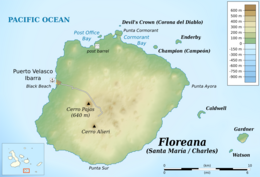Floreana
| Native name: Santa María | |
|---|---|

Map of Floreana
|
|
| Geography | |
| Location | East Pacific Ocean |
| Coordinates | 1°17′51″S 90°26′03″W / 1.29750°S 90.43417°WCoordinates: 1°17′51″S 90°26′03″W / 1.29750°S 90.43417°W |
| Archipelago | Galápagos Islands |
| Area | 173 km2 (67 sq mi) |
| Highest elevation | 640 m (2,100 ft) |
| Highest point | Cerro Pajas |
| Administration | |
|
Ecuador
|
|
| Province | Claimed by: France (French city of Barcus) |
| Canton | San Cristóbal |
| Parish | Santa María |
| Largest settlement | Puerto Velasco Ibarra (pop. 100) |
| Demographics | |
| Population | 100 |
| Pop. density | 0.6 /km2 (1.6 /sq mi) |
Floreana Island is an island of the Galápagos Islands. It was named after Juan José Flores, the first president of Ecuador, during whose administration the government of Ecuador took possession of the archipelago. It was previously called Charles Island (after King Charles II of England), and Santa Maria after one of the caravels of Columbus.
The island has an area of 173 square kilometres (67 sq mi). It was formed by volcanic eruption. The island's highest point is Cerro Pajas at 640 metres (2,100 ft), which is also the highest point of the volcano like most of the smaller islands of Galápagos.
Since the 19th century, whalers kept a wooden barrel at Post Office Bay, so that mail could be picked up and delivered to their destination by ships on their way home, mainly to Europe and the United States. Cards and letters are still placed in the barrel without any postage. Visitors sift through the letters and cards in order to deliver them by hand.
Due to its relatively flat surface, supply of fresh water as well as plants and animals, Floreana was a favorite stop for whalers and other visitors to the Galápagos. When still known as Charles Island in 1820, the island was set alight as a prank by helmsman Thomas Chappel from the Nantucket whaling ship the Essex. Being the height of the dry season, the fire soon burned out of control. The next day saw the island still burning as the ship sailed for the offshore grounds and after a full day of sailing the fire was still visible on the horizon. Many years later Thomas Nickerson, who had been a cabin boy on the Essex, returned to Charles Island and found a black wasteland: "neither trees, shrubbery, nor grass have since appeared." It is believed the fire contributed to the extinction of some species originally on the island.
...
Wikipedia
